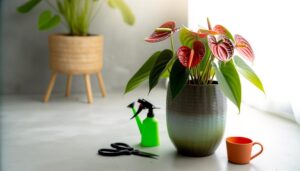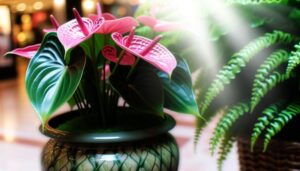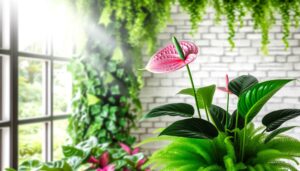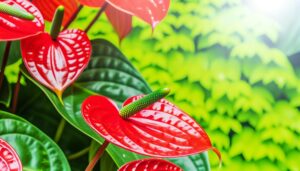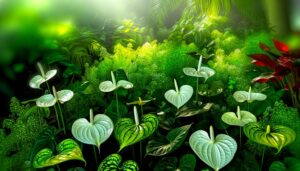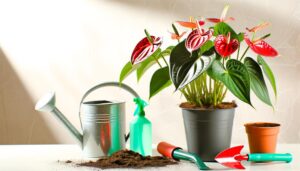Top 5 Affordable White Anthuriums: A Price Comparison
Choosing the top five affordable white Anthuriums involves analyzing aesthetic features and cost-efficiency. Consider Anthurium Andraeanum for its glossy spathes that thrive in organic-rich substrates.
Anthurium Scherzerianum, with its resilient spathes and compact growth, excels in high humidity. Anthurium Clarinervium offers luxuriant heart-shaped leaves and is cost-effective despite needing high humidity.
Anthurium Crystallinum's velvety leaves and adaptable root systems make it a standout. Finally, Anthurium Veitchii, known for its ribbed, glossy leaves, balances affordability with exotic appeal.
For a deeper understanding, explore how each species' unique physiological traits affect their pricing.
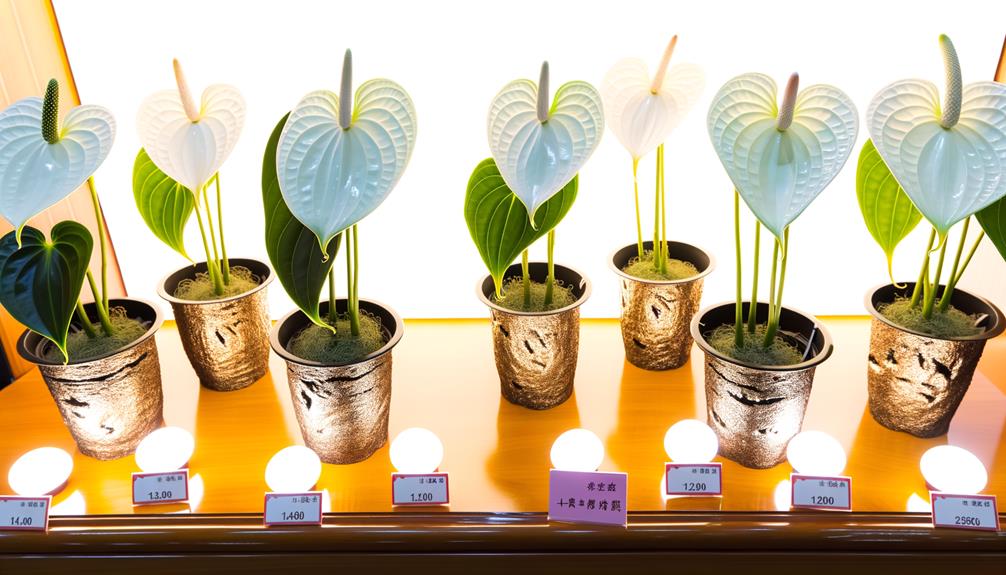
Key Takeaways
- Anthurium Andraeanum offers affordability with its glossy, heart-shaped spathes and vibrant spadices.
- Anthurium Scherzerianum is a cost-effective choice featuring tightly coiled spadix and vibrant spathes.
- Anthurium Clarinervium provides luxury at an affordable price with its striking, heart-shaped leaves and prominent white veins.
- Anthurium Crystallinum's large, velvety leaves and silver-white venation make it an economical option.
- Anthurium Veitchii, known as 'King Anthurium,' boasts deeply corrugated leaves and is budget-friendly despite its regal appearance.
Anthurium Andraeanum
Anthurium andraeanum, commonly referred to as the flamingo flower, is a species distinguished by its glossy, heart-shaped spathes and vibrant spadices.
When you observe this plant, you'll notice its unique spathe, which is often confused for a flower petal. The spathe's peak-gloss texture results from specialized epidermal cells that reflect light, enhancing its charm.
The spadix, a cylindrical structure, contains numerous tiny flowers, contributing to the plant's reproductive success.
This species thrives in well-draining, organic-rich substrates, requiring consistent moisture yet avoiding waterlogged conditions. Ideal growth occurs under indirect light, resembling its native tropical habitat.
With its striking appearance and relatively manageable care requirements, Anthurium andraeanum offers both aesthetic appeal and horticultural satisfaction at a reasonable price.
Anthurium Scherzerianum
You'll find Anthurium scherzerianum, often known as the pigtail plant, easily recognizable by its distinct, tightly coiled spadix and vibrant, waxy spathes. This species, native to Costa Rica, thrives in high humidity and indirect light conditions. Its spathes, typically red or orange, provide a stark contrast against its green foliage.
| Characteristic | Description |
|---|---|
| Spadix | Tightly coiled, pig-tail shape |
| Spathes | Vibrant, waxy, usually red/orange |
| Native Habitat | Costa Rica |
| Light Requirements | Indirect light |
| Humidity Needs | High |
You'll appreciate its unique morphology and resilience, making it an affordable and durable choice for indoor gardening. The compact growth habit means it fits well in smaller spaces, and its humidity preference mirrors typical household environments.
Anthurium Clarinervium
Renowned for its striking, heart-shaped leaves with prominent white veins, Anthurium clarinervium captivates enthusiasts with both its aesthetic appeal and unique physiological traits. You'll notice its velvety foliage, rich in chlorophyll, efficiently conducts photosynthesis, ensuring robust growth. The white venation isn't just visually stunning; it enhances light reflection, optimizing light absorption.
When you care for Anthurium clarinervium, maintain high humidity levels, ideally around 70-80%. It's sensitive to overwatering, so guarantee well-draining soil to prevent root rot. Temperature consistency, ideally between 65-80°F, is essential for its metabolic processes.
Economically, this species offers an affordable yet luxurious option for plant aficionados. Its moderate price doesn't compromise its exotic allure, making it a cherished addition to your botanical collection.
Anthurium Crystallinum
Many consider Anthurium crystallinum a standout species due to its large, velvety leaves with striking silver-white venation that enhances its photosynthetic efficiency. You'll appreciate its adaptability to indoor conditions and how its foliage's high chlorophyll content enhances light absorption.
This species' root system prefers well-draining substrates, ensuring robust growth.
To maintain its health, consider these key factors:
- Humidity: Maintain 60-80% humidity levels for best leaf development.
- Light: Provide bright, indirect light to avoid leaf scorch.
- Watering: Water consistently, allowing the top inch of soil to dry out between sessions.
- Fertilization: Use a balanced, water-soluble fertilizer monthly during the growing season.
Anthurium Veitchii
Known as the 'King Anthurium,' Anthurium veitchii boasts long, deeply corrugated leaves that can reach impressive lengths, making it a striking addition to any botanical collection. You'll appreciate its unique foliar architecture, characterized by pronounced ribbing and a glossy surface, which enhances its visual appeal.
This species thrives in high-humidity environments, mimicking its native rainforest habitat. When selecting a Veitchii, opt for specimens with vibrant, unblemished leaves to promote robust growth. Its preference for well-draining, aerated substrates like a mix of orchid bark and perlite promotes peak root health.
Regular misting and indirect, bright light will keep your Anthurium thriving. Despite its regal appearance, it's surprisingly affordable, making it an excellent choice for both novice and seasoned collectors.
Conclusion
So, you've explored the crème de la crème of affordable white anthuriums, and now you're practically a botanist, right?
We've dissected prices like a lab experiment, and you've seen that Anthurium Andraeanum won't break the bank, while Anthurium Veitchii might demand a bit more of your lunch money.
In this horticultural showdown, you've got the data to make an informed choice—because, clearly, your indoor garden's fiscal health is paramount.
Happy plant shopping, budget-conscious botanist!

